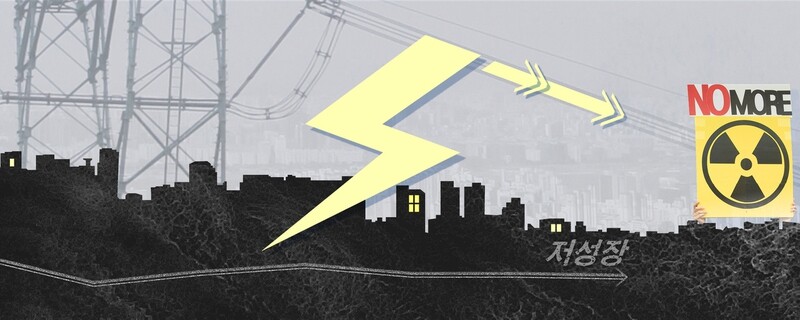hankyoreh
Links to other country sites 다른 나라 사이트 링크
South Korean electricity demand to peak in 2030, suggesting a period of low growth

South Korea’s peak demand for electricity in 2030 will be 101.9GW, which is much lower than the 113.2GW demand that was forecast two years ago, a group of experts predicts. The 11.3GW decrease is equivalent to the installed capacity of 7 to 10 nuclear reactors (which each generate between 1.1 and 1.5GW). This hints that major changes are coming to the current plan, which presumes the necessity of operating two more nuclear reactors in 2028 and 2029.
At COEX, in the Samsung neighborhood of Seoul, on July 13, a working group for predicting demand for the eighth basic plan for electric power supply and demand, which is composed of private-sector experts appointed by the Ministry of Trade, Industry and Energy, released their predictions for domestic power demand between 2017 and 2031 that will be reflected in the eighth electric power plan.
According to the Electricity Business Act, the Ministry must establish a basic plan for electric power supply and demand every two years in order to ensure a stable supply of electricity. These mid- to long-range plans, which forecast electric power policy for the next 15 years, are used by the Ministry to design power facilities and set the power mix based on projected demand for electricity. The role of the working group is to produce the power demand projections that will be used as decision-making criteria by the six groups of experts that was set up by the Ministry to frame the eighth power plan at the end of last year.
This projection for peak demand represented the greatest decrease relative to the previous projection. Power usage had been soaring in South Korea because of its rapid industrialization, but this indicates that the country has now entered a period of low-growth. “The peak energy projection for 2030 of 101.9GW is around 11.3GW lower than the projection made [two years ago] in the seventh power plan [2015-2029] of 113.2GW,” said Yu Seung-hun, chair of the working group and professor of energy policy at the Seoul National University of Science and Technology.
“This is the first time there has been such dramatic change. The biggest factor was that the projection for the GDP growth rate fell,” explained Kim Chang-sik, another member of the group and an economics professor at Sungkyunkwan University. The economic growth rate reflected in the eight power plan was 2.5%, lower than the rate of 3.4% reflected in the seventh power plan.
This is expected to fuel the new government’s plan to increase new and renewable energy to 20% of the total energy supply by 2030, to stop extending the lifespan of nuclear reactors and to halt the construction of new nuclear reactors. It’s also likely to have a major influence on the eighth power plan, which will be finalized at the end of this year, and on the third basic energy plan, which will be framed at the beginning of next year.
By Kim Sung-hwan, staff reporter
Please direct questions or comments to [english@hani.co.kr]

Editorial・opinion
![[Column] Season 2 of special prosecutor probe may be coming to Korea soon [Column] Season 2 of special prosecutor probe may be coming to Korea soon](https://flexible.img.hani.co.kr/flexible/normal/500/300/imgdb/original/2024/0426/3317141030699447.jpg) [Column] Season 2 of special prosecutor probe may be coming to Korea soon
[Column] Season 2 of special prosecutor probe may be coming to Korea soon![[Column] Park Geun-hye déjà vu in Yoon Suk-yeol [Column] Park Geun-hye déjà vu in Yoon Suk-yeol](https://flexible.img.hani.co.kr/flexible/normal/500/300/imgdb/original/2024/0424/651713945113788.jpg) [Column] Park Geun-hye déjà vu in Yoon Suk-yeol
[Column] Park Geun-hye déjà vu in Yoon Suk-yeol- [Editorial] New weight of N. Korea’s nuclear threats makes dialogue all the more urgent
- [Guest essay] The real reason Korea’s new right wants to dub Rhee a founding father
- [Column] ‘Choson’: Is it time we start referring to N. Korea in its own terms?
- [Editorial] Japan’s rewriting of history with Korea has gone too far
- [Column] The president’s questionable capacity for dialogue
- [Column] Are chaebol firms just pizza pies for families to divvy up as they please?
- [Column] Has Korea, too, crossed the Rubicon on China?
- [Correspondent’s column] In Japan’s alliance with US, echoes of its past alliances with UK
Most viewed articles
- 11 in 5 unwed Korean women want child-free life, study shows
- 2AI is catching up with humans at a ‘shocking’ rate
- 3[Column] Has Korea, too, crossed the Rubicon on China?
- 4[Column] Season 2 of special prosecutor probe may be coming to Korea soon
- 5Division commander ordered troops to enter raging flood waters before Marine died, survivor says
- 6[Photo] More Sewol paintings by Hong Sung-dam
- 7Court dismisses comfort women’s suit against government for signing 2015 agreement with Japan
- 8[Editorial] Seoul’s callous response to disability rights protests
- 9Netflix imperialism: Are Korea’s days as the platform’s favorite content creator numbered?
- 10Marriages nosedived 40% over last 10 years in Korea, a factor in low birth rate